Decoding Global Palates: Unveiling Cross-Cultural Flavor Preferences Through Online Recipes
Abstract
1. Introduction
2. Materials and Methods
2.1. Data Collection
2.2. Recipe Representation and Model Training
2.3. Design of the Exploratory Analyses
2.3.1. Identifying Savory and Sweet Recipes by Means of Ingredient Complement Networks
- Step 1: Generating ingredient complement networks
- Step 2: Representing ingredients and recipes using Node2Vec
- Step 3: K-means on the recipe representation
- Step 4: Calculating the proportion of savory/sweet recipes in appreciated and less appreciated recipes
2.3.2. Building Semantic Clusters for Flavor Compounds Based on Their Corresponding Flavor Profiles
- Step 1: Representing flavor compounds with their corresponding flavor profiles
- Step 2: K-means on the representation of flavor compounds
- Step 3: Assigning semantic description for each cluster
3. Results
3.1. Recipe Origin Prediction with Ingredients and Flavor Compounds
3.2. Identifying Intra- and Inter-Cultural Flavor Preferences with Machine Learning Approaches
3.3. Exploratory Analyses Justified the Discovered Patterns in Cross-Cultural Flavor Preferences
3.3.1. Preferences for Savory and Sweet Recipes Across Cultures
3.3.2. Preferences for Sweet and Non-Sweet Flavors Across Cultures
4. Discussion
4.1. Theoretical Implications
4.2. Practical Implications
- User Profiling Based on Cultural Preferences: The recommender system could incorporate user profiling that considers cultural background and flavor preferences. By asking users for their cultural backgrounds or inferring preferences based on their recipe interactions, this approach enables better alignment between users and food ontology [70], as well as recommend recipes that align with regional flavor profiles.
- Flavor-Based Collaborative Filtering: Collaborative filtering is a widely used approach in food recommender systems [71]. Previous studies have primarily clustered users’ preferences based on ingredient similarity [72,73,74]. Our findings suggest a new possibility of recommending food based on shared cultural backgrounds or flavor preferences, allowing users to receive personalized suggestions based on the choices of others with similar tastes.
- Incorporating Contextual Factors: Contextual information has been proposed to enhance the performance of food recommender systems [75,76,77]. Our findings suggest that integrating cultural factors, including regional food availability and traditional meal structures (e.g., the balance of flavors in different cuisines), could guide the recommendations to align better with users’ expectations based on their cultural preferences.
4.3. Limitations and Future Directions
5. Conclusions
Author Contributions
Funding
Institutional Review Board Statement
Informed Consent Statement
Data Availability Statement
Conflicts of Interest
Appendix A
Appendix A.1. Multilingual Recipe Data Preprocessing
- Removing non-ingredients terms: The majority of online recipes were composed in free-text format, often containing non-ingredient terms such as punctuation, and emojis, as well as kitchen/eating utensils (e.g., aluminum foil, bowl), amounts, and units (e.g., 2 L, 1/4 pounds etc.). In our dataset, we retained only the ingredients, removing all non-ingredient terms.
- Translating the ingredient lists: In this step, we translated the ingredient lists of online recipes in Chinese and German to English. To facilitate this process, we initiated translation requests to Google Cloud Translation API v2 (https://cloud.google.com/translate/docs/basic/translating-text, accessed on 14 April 2025), allowing for automated translation. Although this automated approach successfully translated the bulk of the ingredient lists, it is important to note that there were instances where certain ingredients were inaccurately translated. To address this, we conducted a manual review and made necessary correctiosn to the translations.
- Removing the “stop words”: In this study, “stop words” refer to frequently occurring non-noun words in online recipes, often adverbs, adjectives, or past tense verbs, which can interfere with the mapping process. For instance, “very ripe bananas” or “chopped onion” contain “stop words” such “very”, “ripe”, and “chopped”. To identify these “stop words”, we employed the Stanford NLP Group’s Part-of-Speech Tagger (POS Tagger), which successfully recognized most non-noun words as “stop words”. However, exceptions existed, such as the use of certain nouns such as “slice” in “bacon in slice”, “sticks” in “cinnamon sticks”, and “chunks” in “pineapple chunks”, which needed to be removed. However, some non-noun words like “green” in “green beans” and “sweet” in “sweet potato” could not be removed without altering the ingredient meaning and were handled manually.
- Mapping ingredients to FlavorDB entities: After the processes above, there were ingredients that could be mapped to entities in FlavorDB directly. Nevertheless, to maximize the coverage of ingredient mapping, a substantial portion of manual work was undertaken. Here, we outline several common situations encountered during this manual process and our corresponding approaches. We first standardized the ingredients according to the entity granularity within FlavorDB. For example, the variations in ingredients (e.g., apple variations Goldparmäne, Boskop) were normalized to their broader categories. Similarly, components of poultry/animal products, such as chicken breast/wings, egg yolk/white, were unified with their respective origins. In addition, extracts or products used in recipes, such as orange juice and anise powder, were aligned with their fundamental components. Apart from the aforementioned ingredients, there were also food products or mixed ingredients, such as strawberry yogurt. In such cases, we modeled strawberry yogurt as flavor compounds of strawberry and yogurt, as strawberry yogurt has the flavors of both strawberry and yogurt. This modeling approach was also extended to ingredients such as vanilla pudding and chocolate cream. Similarly, we applied this process to mixed spices like Herbes de Provence and Suppengrün. We divided these into individual ingredients based on authority recipes or appreciated recipes from the recipe portals.
| Origin | Num. Raw Termsin Recipes 1 | Num. Processed Ingredients in Recipes 2 | Num. Ingredients with Flavor Compounds |
|---|---|---|---|
| Xiachufang | 10,584 | 973 | 331 |
| Allrecipes | 30,333 | 824 | 356 |
| Kochbar | 42,022 | 2084 | 401 |
Appendix A.2. Recipe Representation with Word2Vec
- size: This parameter determines the dimension of vectors for representing each word. We applied the default value 100 in this work, so that each ingredient was represented by a 100-dimensional vector.
- min_count: This parameter regulates the minimum frequency of words that can be input into the model. To be specific, if the default value of min_count is 5, then only words that occur more than or equal to five times would be input into the model. In this work, we set the value to 1, in order to represent every ingredient and flavor compound in the dataset.
- window: This parameter determines how many words around the target word are taken into consideration when the model is training. We used the default value of 5 in this work, which means that for each ingredient/flavor compound in the recipe, the model learns its embeddings by considering five ingredients/flavor compounds before and after it.
Appendix B. Ingredient Representation with Node2Vec
- dimensions: This parameter refers to the dimensions of the generated node embeddings. We chose the default value 128, so that each ingredient in the networks was represented as a 128-dimensional vector.
- num_walks: This parameter determines the number of random walks per node. The default value of the parameter is 10. However, optimal parameter values may vary across different scenarios [64]; thus, we undertook a series of experiments to evaluate various values for this parameter. Specifically, during the generation of the node embeddings for the ingredients in the complement networks of recipes in the Xiachufang, Allrecipes, and Kochbar collections, values from 10 to 25 were examined. To effectively analyze the resulting node embeddings, we applied UMAP to display these in a two-dimensional layout. The insights gained from these visualizations guided our determination of which parameter value most effectively reflects the underlying structure of the networks.
- walk_length: This parameter indicates the number of nodes traversed in each random walk. The default value is 80. We employed a similar approach to determine the value for this parameter to that which we used for num_walk. A range from 15 to 25 was tested to ascertain the optimal settings for this parameter.
- p and q: p refers to the Return hyperparameter, determining the possibility of revisiting a former node in a walk after visiting a node. Setting a higher value of p ensures a lower chance of revisiting a node. The default value of p is 1, and we set it to 2 to enable a broader exploration of the graph. q is the Inout hyperparameter, determining the probability of exploring undiscovered nodes. A high value of q (q > 1) allows a random walk towards the closer neighbors of the previous nodes, which leads to a local view of the network with respect to the start node in the walk and approximate Breadth first Sampling (BFS) behavior. In contrast, a lower value of q (q < 1) encourages the walk to explore the network with Depth first Sampling (DFS) behavior and offers a macro-view of the network. The default q is 1. In this work, we set q to 0.25 in order to obtain a macro-view of the ingredient complement networks.
Appendix C



References
- Rozin, P. The socio-cultural context of eating and food choice. In Food Choice, Acceptance and Consumption; Springer: New York, NY, USA, 1996; pp. 83–104. [Google Scholar]
- Palojoki, P.; Tuomi-Gröhn, T. The complexity of food choices in an everyday context. Int. J. Consum. Stud. 2001, 25, 15–23. [Google Scholar] [CrossRef]
- Köster, E.P. Diversity in the determinants of food choice: A psychological perspective. Food Qual. Prefer. 2009, 20, 70–82. [Google Scholar] [CrossRef]
- Monterrosa, E.C.; Frongillo, E.A.; Drewnowski, A.; de Pee, S.; Vandevijvere, S. Sociocultural influences on food choices and implications for sustainable healthy diets. Food Nutr. Bull. 2020, 41, 59S–73S. [Google Scholar] [CrossRef]
- Rozin, P. Human food intake and choice: Biological, psychological and cultural perspectives. In Food Selection: From Genes to Culture; Anderson, H., Blundell, J., Chiva, M., Eds.; Danone Institute: Levallois-Perret, France, 2002; pp. 7–26. [Google Scholar]
- Chrzan, J.; Brett, J. Food Culture: Anthropology, Linguistics and Food Studies; Berghahn Books: Oxford, UK, 2017; Volume 2. [Google Scholar]
- Djekic, I.; Bartkiene, E.; Szűcs, V.; Tarcea, M.; Klarin, I.; Černelić-Bizjak, M.; Isoldi, K.; Ayman, E.K.; Ferreira, V.; Klava, D.; et al. Cultural dimensions associated with food choice: A survey based multi-country study. Int. J. Gastron. Food Sci. 2021, 26, 100414. [Google Scholar] [CrossRef]
- Chen, P.J.; Antonelli, M. Conceptual Models of Food Choice: Influential Factors Related to Foods, Individual Differences, and Society. Foods 2020, 9, 1898. [Google Scholar] [CrossRef] [PubMed]
- Ahn, Y.Y.; Ahnert, S.E.; Bagrow, J.P.; Barabási, A.L. Flavor network and the principles of food pairing. Sci. Rep. 2011, 1, 196. [Google Scholar] [CrossRef]
- Zhu, Y.X.; Huang, J.; Zhang, Z.K.; Zhang, Q.M.; Zhou, T.; Ahn, Y.Y. Geography and similarity of regional cuisines in China. PLoS ONE 2013, 8, e79161. [Google Scholar] [CrossRef]
- Silva, T.; De Melo, P.V.; Almeida, J.; Musolesi, M.; Loureiro, A. You are what you eat (and drink): Identifying cultural boundaries by analyzing food and drink habits in foursquare. In Proceedings of the International AAAI Conference on Web and Social Media, Ann Arbor, MI, USA, 1–4 June 2014; Volume 8, pp. 466–475. [Google Scholar]
- Kim, K.J.; Chung, C.H. Tell me what you eat, and I will tell you where you come from: A data science approach for global recipe data on the web. IEEE Access 2016, 4, 8199–8211. [Google Scholar] [CrossRef]
- Min, W.; Bao, B.K.; Mei, S.; Zhu, Y.; Rui, Y.; Jiang, S. You are what you eat: Exploring rich recipe information for cross-region food analysis. IEEE Trans. Multimed. 2017, 20, 950–964. [Google Scholar] [CrossRef]
- Fischler, C. Food, self and identity. Soc. Sci. Inf. 1988, 27, 275–292. [Google Scholar] [CrossRef]
- Torrico, D.D.; Fuentes, S.; Viejo, C.G.; Ashman, H.; Dunshea, F.R. Cross-cultural effects of food product familiarity on sensory acceptability and non-invasive physiological responses of consumers. Food Res. Int. 2019, 115, 439–450. [Google Scholar] [CrossRef] [PubMed]
- Fibri, D.L.N.; Frøst, M.B. Consumer perception of original and modernised traditional foods of Indonesia. Appetite 2019, 133, 61–69. [Google Scholar] [CrossRef] [PubMed]
- Bardhi, F.; Ostberg, J.; Bengtsson, A. Negotiating cultural boundaries: Food, travel and consumer identities. Consum. Mark. Cult. 2010, 13, 133–157. [Google Scholar] [CrossRef]
- Zhu, Y.; Zhu, L.; Weng, L. How do tourists’ value perceptions of food experiences influence their perceived destination image and revisit intention? A moderated mediation model. Foods 2024, 13, 412. [Google Scholar] [CrossRef]
- Elsweiler, D.; Hauptmann, H.; Trattner, C. Food Recommender Systems. In Recommender Systems Handbook; Ricci, F., Rokach, L., Shapira, B., Eds.; Springer: New York, NY, USA, 2022; pp. 871–925. [Google Scholar] [CrossRef]
- Askegaard, S.; Madsen, T.K. The local and the global: Exploring traits of homogeneity and heterogeneity in European food cultures. Int. Bus. Rev. 1998, 7, 549–568. [Google Scholar] [CrossRef]
- Rozin, P.; Fischler, C.; Imada, S.; Sarubin, A.; Wrzesniewski, A. Attitudes to food and the role of food in life in the USA, Japan, Flemish Belgium and France: Possible implications for the diet–health debate. Appetite 1999, 33, 163–180. [Google Scholar] [CrossRef]
- Risso, D.S.; Giuliani, C.; Antinucci, M.; Morini, G.; Garagnani, P.; Tofanelli, S.; Luiselli, D. A bio-cultural approach to the study of food choice: The contribution of taste genetics, population and culture. Appetite 2017, 114, 240–247. [Google Scholar] [CrossRef]
- Woo, J.; Woo, K.; Leung, S.; Chook, P.; Liu, B.; Ip, R.; Ho, S.; Chan, S.; Feng, J.; Celermajer, D. The Mediterranean score of dietary habits in Chinese populations in four different geographical areas. Eur. J. Clin. Nutr. 2001, 55, 215–220. [Google Scholar] [CrossRef]
- Fontefrancesco, M.F.; Zocchi, D.M.; Pieroni, A. The intersections between food and cultural landscape: Insights from three mountain case studies. Land 2023, 12, 676. [Google Scholar] [CrossRef]
- Linné, Y.; Barkeling, B.; Rössner, S.; Rooth, P. Vision and eating behavior. Obes. Res. 2002, 10, 92–95. [Google Scholar] [CrossRef]
- Mertens, E.; Kuijsten, A.; Dofková, M.; Mistura, L.; D’Addezio, L.; Turrini, A.; Dubuisson, C.; Favret, S.; Havard, S.; Trolle, E.; et al. Geographic and socioeconomic diversity of food and nutrient intakes: A comparison of four European countries. Eur. J. Nutr. 2019, 58, 1475–1493. [Google Scholar] [CrossRef] [PubMed]
- Marshall, D. Food as ritual, routine or convention. Consum. Mark. Cult. 2005, 8, 69–85. [Google Scholar] [CrossRef]
- Savvaidis, I.N.; Al Katheeri, A.; Lim, S.H.E.; Lai, K.S.; Abushelaibi, A. Traditional foods, food safety practices, and food culture in the Middle East. In Food Safety in the Middle East; Elsevier: Amsterdam, The Netherlands, 2022; pp. 1–31. [Google Scholar]
- Cohen, A.B. You can learn a lot about religion from food. Curr. Opin. Psychol. 2021, 40, 1–5. [Google Scholar] [CrossRef] [PubMed]
- Chouraqui, J.P.; Turck, D.; Briend, A.; Darmaun, D.; Bocquet, A.; Feillet, F.; Frelut, M.L.; Girardet, J.P.; Guimber, D.; Hankard, R.; et al. Religious dietary rules and their potential nutritional and health consequences. Int. J. Epidemiol. 2021, 50, 12–26. [Google Scholar] [CrossRef] [PubMed]
- Dhar, A.R.; Oita, A.; Matsubae, K. The effect of religious dietary cultures on food nitrogen and phosphorus footprints: A case study of India. Nutrients 2021, 13, 1926. [Google Scholar] [CrossRef]
- Drewnowski, A. Why do we like fat? J. Am. Diet. Assoc. 1997, 97, S58–S62. [Google Scholar] [CrossRef]
- Rolls, E.T. Taste, olfactory, and food texture processing in the brain, and the control of food intake. Physiol. Behav. 2005, 85, 45–56. [Google Scholar] [CrossRef]
- Hiroko, T. Delicious food in a beautiful country: Nationhood and nationalism in discourses on food in contemporary Japan. Stud. Ethn. Natl. 2008, 8, 5–30. [Google Scholar] [CrossRef]
- Gutierrez, R.; Simon, S.A. Physiology of taste processing in the tongue, gut, and brain. Compr. Physiol. 2021, 11, 2489–2523. [Google Scholar] [CrossRef]
- Spence, C.; Okajima, K.; Cheok, A.D.; Petit, O.; Michel, C. Eating with our eyes: From visual hunger to digital satiation. Brain Cogn. 2016, 110, 53–63. [Google Scholar] [CrossRef]
- Sajadmanesh, S.; Jafarzadeh, S.; Ossia, S.A.; Rabiee, H.R.; Haddadi, H.; Mejova, Y.; Musolesi, M.; Cristofaro, E.D.; Stringhini, G. Kissing cuisines: Exploring worldwide culinary habits on the web. In Proceedings of the 26th International Conference on World Wide Web Companion, Perth, Australia, 3–7 April 2017; pp. 1013–1021. [Google Scholar]
- Wagner, C.; Singer, P.; Strohmaier, M. The nature and evolution of online food preferences. EPJ Data Sci. 2014, 3, 1–22. [Google Scholar] [CrossRef]
- Tuwani, R.; Sahoo, N.; Singh, N.; Bagler, G. Computational models for the evolution of world cuisines. In Proceedings of the 2019 IEEE 35th International Conference on Data Engineering Workshops (ICDEW), Macao, China, 8–12 April 2019; IEEE: Piscataway, NJ, USA; pp. 85–90. [Google Scholar]
- Zhang, Q.; Elsweiler, D.; Trattner, C. Visual cultural biases in food classification. Foods 2020, 9, 823. [Google Scholar] [CrossRef]
- Zhang, Q.; Elsweiler, D.; Trattner, C. Understanding and predicting cross-cultural food preferences with online recipe images. Inf. Process. Manag. 2023, 60, 103443. [Google Scholar] [CrossRef]
- Moskowitz, H.W.; Kumaraiah, V.; Sharma, K.; Jacobs, H.; Sharma, S. Cross-cultural differences in simple taste preferences. Science 1975, 190, 1217–1218. [Google Scholar] [CrossRef]
- Sjöstrand, A.E.; Sjödin, P.; Hegay, T.; Nikolaeva, A.; Shayimkulov, F.; Blum, M.G.; Heyer, E.; Jakobsson, M. Taste perception and lifestyle: Insights from phenotype and genome data among Africans and Asians. Eur. J. Hum. Genet. 2021, 29, 325–337. [Google Scholar] [CrossRef] [PubMed]
- Goel, M.; Bagler, G. Computational gastronomy: A data science approach to food. J. Biosci. 2022, 47, 12. [Google Scholar] [CrossRef]
- Jain, A.; Rakhi, N.K.; Bagler, G. Spices form the basis of food pairing in Indian cuisine. arXiv 2015, arXiv:1502.03815. [Google Scholar]
- Tallab, S.T.; Alrazgan, M.S. Exploring the food pairing hypothesis in Arab cuisine: A study in computational gastronomy. Procedia Comput. Sci. 2016, 82, 135–137. [Google Scholar] [CrossRef]
- Zhou, J.; Xin, X.; Li, W.; Ding, H.; Yu, S.; Cui, X. Flavor analysis and region prediction of Chinese dishes based on food pairing. Inf. Process. Manag. 2024, 61, 103684. [Google Scholar] [CrossRef]
- Fenaroli, G. Fenaroli’s Handbook of Flavor Ingredients; Burdock, G., Ed.; Taylor & Francis: Abingdon, UK, 2004. [Google Scholar]
- Garg, N.; Sethupathy, A.; Tuwani, R.; Nk, R.; Dokania, S.; Iyer, A.; Gupta, A.; Agrawal, S.; Singh, N.; Shukla, S.; et al. FlavorDB: A database of flavor molecules. Nucleic Acids Res. 2018, 46, D1210–D1216. [Google Scholar] [CrossRef]
- Said, A.; Bellogín, A. You are What You Eat! Tracking Health Through Recipe Interactions. In Proceedings of the 6th Workshop on Recommender Systems and the Social Web (RSWeb 2014), Foster City, CA, USA, 10 June 2014. [Google Scholar]
- Trattner, C.; Parra, D.; Elsweiler, D. Monitoring obesity prevalence in the United States through bookmarking activities in online food portals. PLoS ONE 2017, 12, e0179144. [Google Scholar] [CrossRef] [PubMed]
- West, R.; White, R.W.; Horvitz, E. From cookies to cooks: Insights on dietary patterns via analysis of web usage logs. In Proceedings of the 22nd International Conference on World Wide Web, Rio de Janeiro, Brazil, 13–17 May 2013; pp. 1399–1410. [Google Scholar]
- Trattner, C.; Moesslang, D.; Elsweiler, D. On the predictability of the popularity of online recipes. EPJ Data Sci. 2018, 7, 1–39. [Google Scholar] [CrossRef]
- El Majjodi, A.; Starke, A.D.; Trattner, C. Nudging towards health? examining the merits of nutrition labels and personalization in a recipe recommender system. In Proceedings of the 30th ACM Conference on User Modeling, Adaptation and Personalization, Barcelona, Spain, 4–7 July 2022; pp. 48–56. [Google Scholar]
- Angelsen, A.; Starke, A.D.; Trattner, C. Healthiness and environmental impact of dinner recipes vary widely across developed countries. Nature Food 2023, 4, 407–415. [Google Scholar] [CrossRef] [PubMed]
- Similarweb. Website Traffic Checker. 2025. Available online: https://www.similarweb.com/website/ (accessed on 3 March 2025).
- Trattner, C.; Elsweiler, D.; Howard, S. Estimating the healthiness of internet recipes: A cross-sectional study. Front. Public Health 2017, 5, 16. [Google Scholar] [CrossRef]
- Elsweiler, D.; Trattner, C.; Harvey, M. Exploiting food choice biases for healthier recipe recommendation. In Proceedings of the 40th International Acm Sigir Conference on Research and Development in Information Retrieval, Shinjuku, Tokyo, 7–11 August 2017; pp. 575–584. [Google Scholar]
- Trattner, C.; Kusmierczyk, T.; Nørvåg, K. Investigating and predicting online food recipe upload behavior. Inf. Process. Manag. 2019, 56, 654–673. [Google Scholar] [CrossRef]
- Rita, L. Building a Food Recommendation System: Machine Learning to Prevent and Treat Cancer Through Nutrition. Towards Data Science. 2020. Available online: https://medium.com/towards-data-science/building-a-food-recommendation-system-90788f78691a (accessed on 14 April 2025).
- Řehŭřek, R.; Sojka, P. Software framework for topic modelling with large corpora. In Proceedings of the LREC 2010 Workshop on New Challenges for NLP Frameworks, Valletta, Malta, 22 May 2010. [Google Scholar]
- Teng, C.Y.; Lin, Y.R.; Adamic, L.A. Recipe recommendation using ingredient networks. In Proceedings of the 4th annual ACM web science conference, Evanston, IL, USA, 22–24 June 2012; pp. 298–307. [Google Scholar]
- Park, D.; Kim, K.; Kim, S.; Spranger, M.; Kang, J. FlavorGraph: A large-scale food-chemical graph for generating food representations and recommending food pairings. Sci. Rep. 2021, 11, 931. [Google Scholar] [CrossRef] [PubMed]
- Grover, A.; Leskovec, J. node2vec: Scalable feature learning for networks. In Proceedings of the 22nd ACM SIGKDD International Conference on Knowledge Discovery and Data Mining, San Francisco, CA, USA, 13–17 August 2016; pp. 855–864. [Google Scholar]
- Rozin, E. The Flavor-Principle Cookbook; Hawthorn Books: Portland, OR, USA, 2018. [Google Scholar] [CrossRef]
- Monroe, B.L.; Colaresi, M.P.; Quinn, K.M. Fightin’words: Lexical feature selection and evaluation for identifying the content of political conflict. Political Anal. 2008, 16, 372–403. [Google Scholar] [CrossRef]
- Tu, V.P.; Valentin, D.; Husson, F.; Dacremont, C. Cultural differences in food description and preference: Contrasting Vietnamese and French panellists on soy yogurts. Food Qual. Prefer. 2010, 21, 602–610. [Google Scholar] [CrossRef]
- Dupas de Matos, A.; Chen, A.; Maggs, R.; Godfrey, A.J.R.; Weerawarna N.R.P., M.; Hort, J. Cross-cultural differences and acculturation in affective response and sensory perception: A case study across Chinese immigrants and local consumers in New Zealand. Food Qual. Prefer. 2025, 122, 105299. [Google Scholar] [CrossRef]
- Nag, N.; Rao, A.N.; Kulhalli, A.; Mehta, K.S.; Bhattacharya, N.; Ramkumar, P.; Bharadwaj, A.; Sitaram, D.; Jain, R. Flavour enhanced food recommendation. In Proceedings of the 5th International Workshop on Multimedia Assisted Dietary Management, Nice, France, 21 October 2019; pp. 60–66. [Google Scholar]
- Hamdollahi Oskouei, S.; Hashemzadeh, M. FoodRecNet: A comprehensively personalized food recommender system using deep neural networks. Knowl. Inf. Syst. 2023, 65, 3753–3775. [Google Scholar] [CrossRef]
- Papadakis, H.; Papagrigoriou, A.; Panagiotakis, C.; Kosmas, E.; Fragopoulou, P. Collaborative filtering recommender systems taxonomy. Knowl. Inf. Syst. 2022, 64, 35–74. [Google Scholar] [CrossRef]
- Freyne, J.; Berkovsky, S. Intelligent food planning: Personalized recipe recommendation. In Proceedings of the 15th International Conference on Intelligent User Interfaces, Hong Kong, China, 7–10 February 2010; pp. 321–324. [Google Scholar]
- Freyne, J.; Berkovsky, S.; Smith, G. Recipe recommendation: Accuracy and reasoning. In Proceedings of the International Conference on User Modeling, Adaptation, and Personalization, Girona, Spain, 11–15 July 2011; Springer: Berlin/Heidelberg, Germany, 2011; pp. 99–110. [Google Scholar]
- Harvey, M.; Ludwig, B.; Elsweiler, D. You are what you eat: Learning user tastes for rating prediction. In Proceedings of the String Processing and Information Retrieval: 20th International Symposium, SPIRE 2013, Jerusalem, Israel, 7–9 October 2013; Proceedings 20. Springer: Berlin/Heidelberg, Germany, 2013; pp. 153–164. [Google Scholar]
- Rokicki, M.; Herder, E.; Kuśmierczyk, T.; Trattner, C. Plate and prejudice: Gender differences in online cooking. In Proceedings of the 2016 Conference on User Modeling Adaptation and Personalization, Halifax, NS, Canada, 13–17 July 2016; pp. 207–215. [Google Scholar]
- Cheng, H.; Rokicki, M.; Herder, E. The influence of city size on dietary choices. In Proceedings of the Adjunct Publication of the 25th Conference on User Modeling, Adaptation and Personalization, Bratislava, Slovakia, 9–12 July 2017; pp. 231–236. [Google Scholar]
- Maia, R.; Ferreira, J.C. Context-aware food recommendation system. In Proceedings of the World Congress on Engineering and Computer Science WCECS 2018, San Francisco, CA, USA, 23–25 October 2018; pp. 349–356. [Google Scholar]
- U.S. Department of Agriculture; U.S. Department of Health and Human Services. Dietary Guidelines for Americans (2020–2025). 2020. Available online: https://www.dietaryguidelines.gov/ (accessed on 18 March 2023).
- Mößlang, D. Predicting the Popularity of Online Recipes. Master’s Thesis, Graz University of Technology, Graz, Austria, 2017. [Google Scholar]
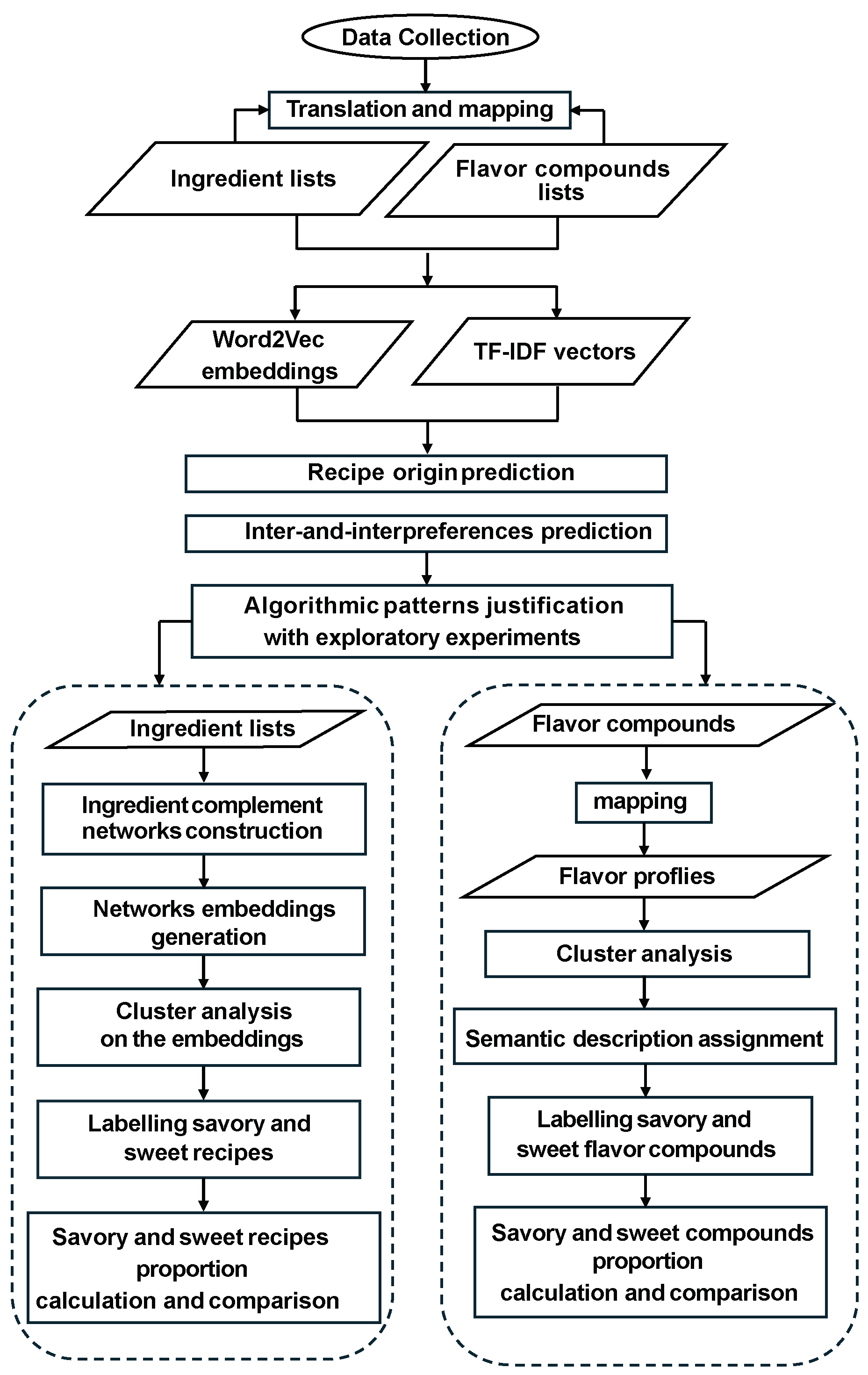

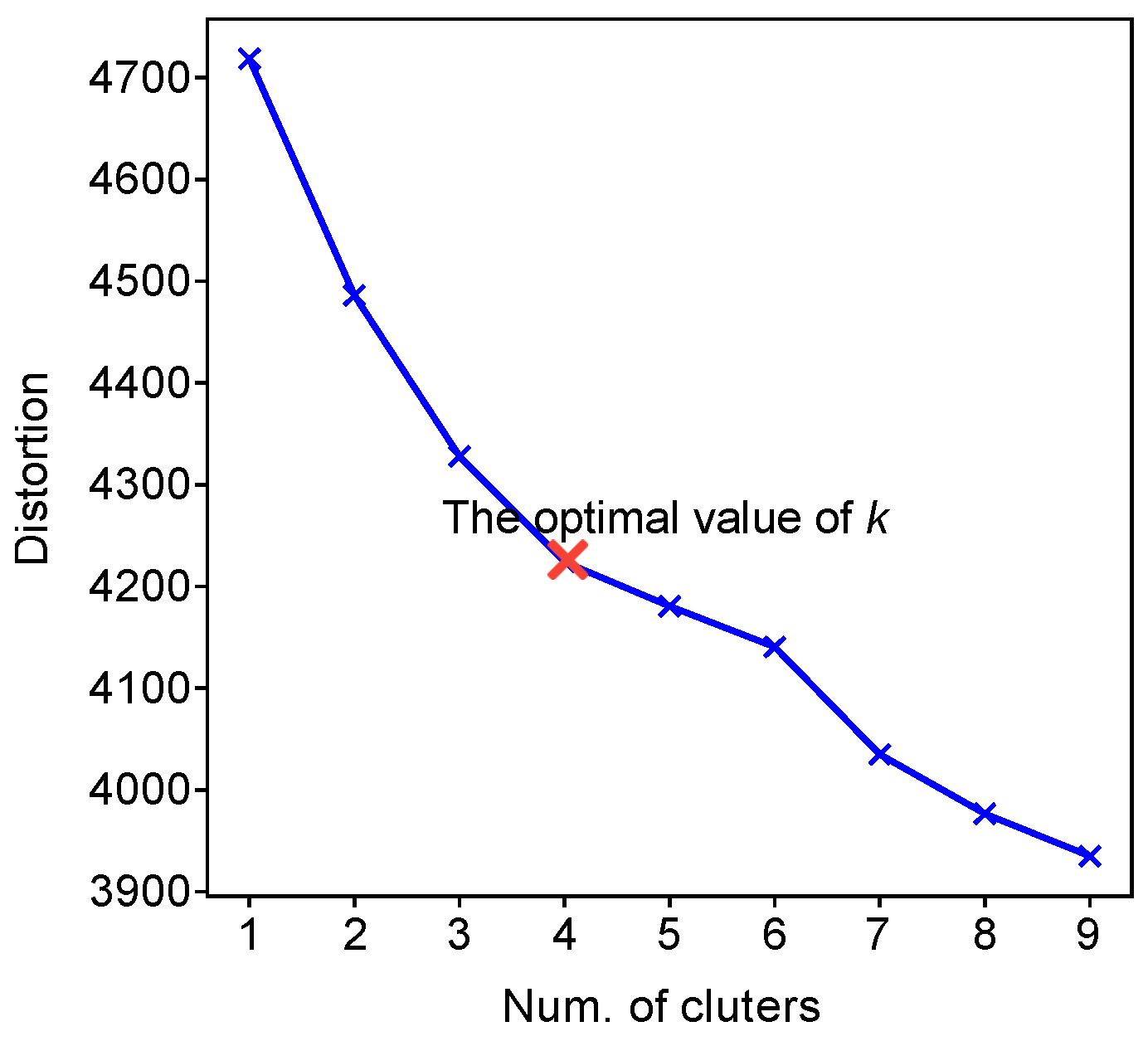
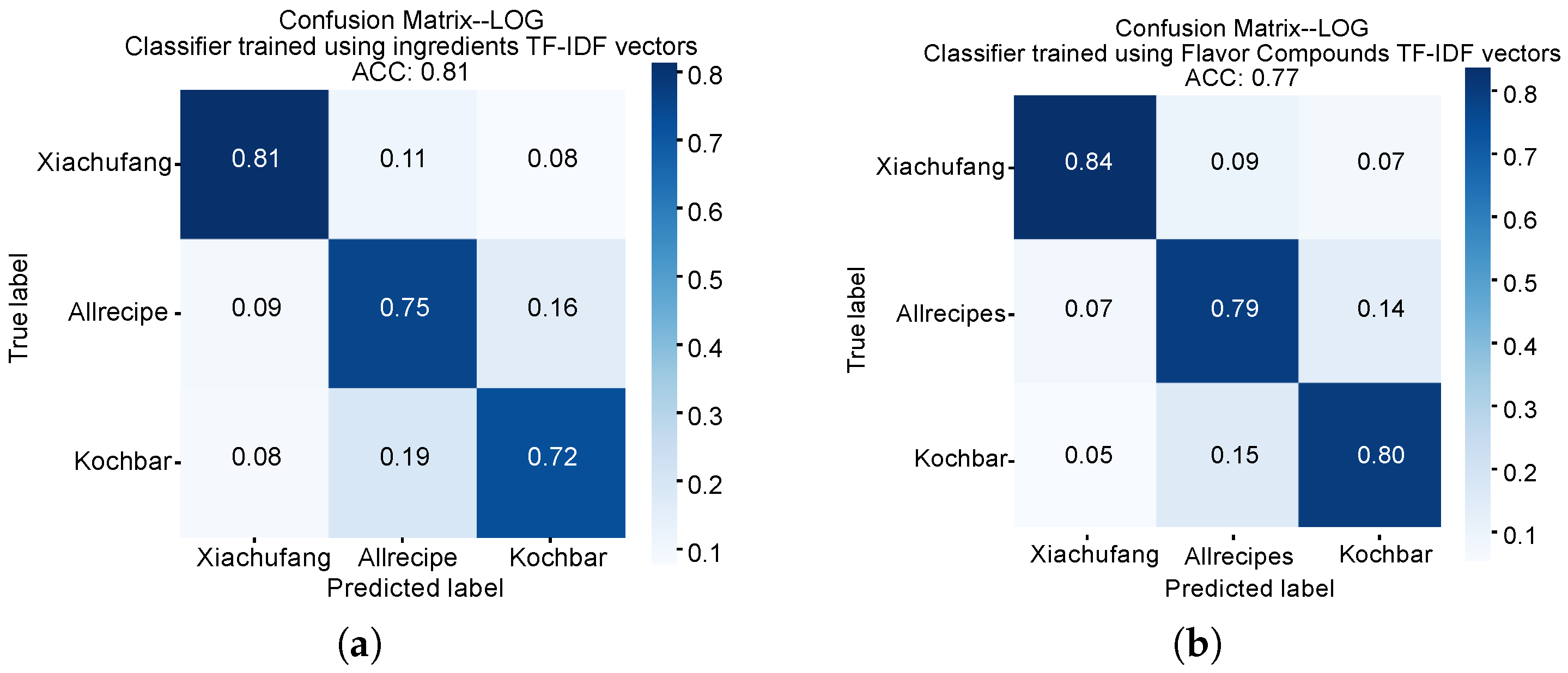

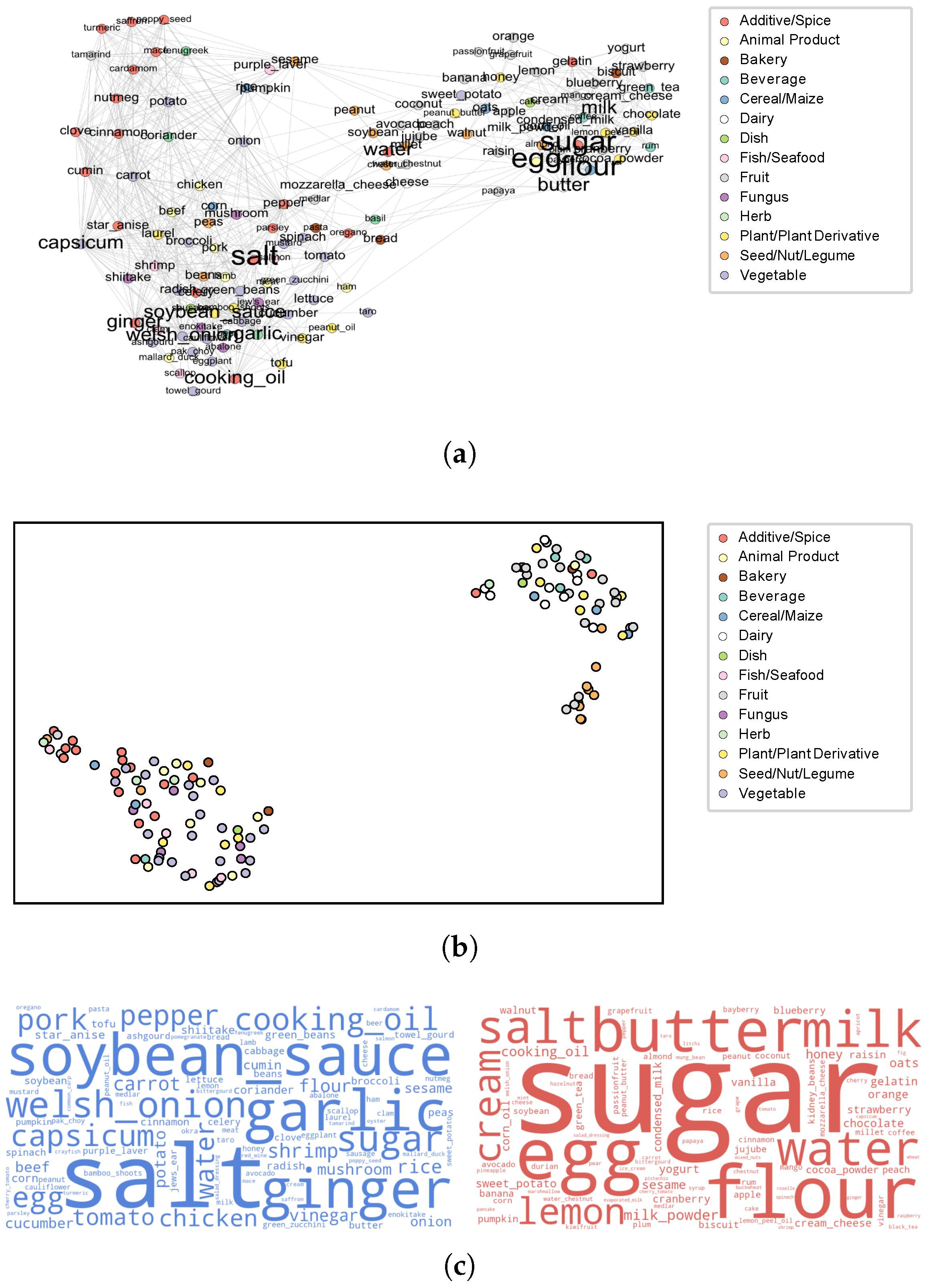


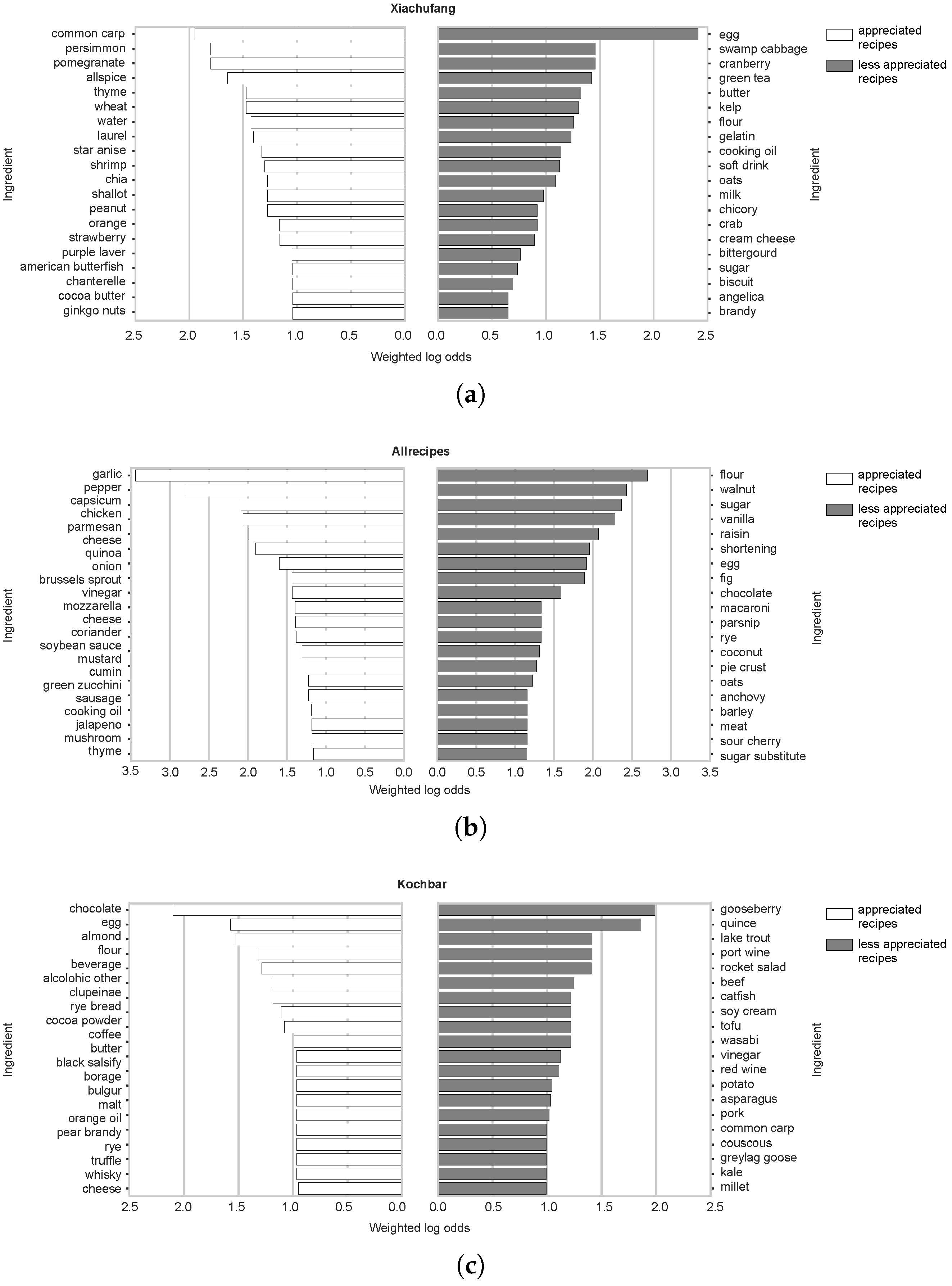
| Features | Accuracy | ||
|---|---|---|---|
| NB | LOG | RF | |
| Ingredient (TF-IDF) | 0.77 | 0.81 | 0.73 |
| Flavor Compounds (TF-IDF) | 0.65 | 0.77 | 0.74 |
| Ingredient (Word2Vec) | 0.56 | 0.73 | 0.72 |
| Flavor Compounds (Word2Vec) | 0.35 | 0.66 | 0.70 |
| Features | Xiachufang | Allrecipes | Kochbar | ||||||
|---|---|---|---|---|---|---|---|---|---|
| Accuracy | Accuracy | Accuracy | |||||||
| NB | LOG | RF | NB | LOG | RF | NB | LOG | RF | |
| Ingredient (TF-IDF) | 0.62 | 0.65 | 0.67 | 0.67 | 0.70 | 0.68 | 0.62 | 0.63 | 0.61 |
| Flavour Compounds (TF-IDF) | 0.60 | 0.61 | 0.66 | 0.64 | 0.66 | 0.67 | 0.59 | 0.65 | 0.64 |
| Ingredient (Word2Vec) | 0.60 | 0.64 | 0.64 | 0.58 | 0.65 | 0.67 | 0.54 | 0.57 | 0.54 |
| Flavour Compounds (Word2Vec) | 0.56 | 0.61 | 0.63 | 0.51 | 0.65 | 0.64 | 0.48 | 0.61 | 0.60 |
| Xiachufang | Allrecipes | Kochbar | ||||
|---|---|---|---|---|---|---|
| Non-Sweet Flavor Compounds | Sweet Flavor Compounds | Non-Sweet Flavor Compounds | Sweet Flavor Compounds | Non-Sweet Flavor Compounds | Sweet Flavor Compounds | |
| Appreciated recipes | 0.45 | 0.55 | 0.47+ | 0.53− | 0.42− | 0.58+ |
| Less appreciated recipes | 0.46 | 0.54 | 0.45 | 0.55 | 0.45 | 0.55 |
Disclaimer/Publisher’s Note: The statements, opinions and data contained in all publications are solely those of the individual author(s) and contributor(s) and not of MDPI and/or the editor(s). MDPI and/or the editor(s) disclaim responsibility for any injury to people or property resulting from any ideas, methods, instructions or products referred to in the content. |
© 2025 by the authors. Licensee MDPI, Basel, Switzerland. This article is an open access article distributed under the terms and conditions of the Creative Commons Attribution (CC BY) license (https://creativecommons.org/licenses/by/4.0/).
Share and Cite
Zhang, Q.; Elsweiler, D.; Trattner, C. Decoding Global Palates: Unveiling Cross-Cultural Flavor Preferences Through Online Recipes. Foods 2025, 14, 1411. https://doi.org/10.3390/foods14081411
Zhang Q, Elsweiler D, Trattner C. Decoding Global Palates: Unveiling Cross-Cultural Flavor Preferences Through Online Recipes. Foods. 2025; 14(8):1411. https://doi.org/10.3390/foods14081411
Chicago/Turabian StyleZhang, Qing, David Elsweiler, and Christoph Trattner. 2025. "Decoding Global Palates: Unveiling Cross-Cultural Flavor Preferences Through Online Recipes" Foods 14, no. 8: 1411. https://doi.org/10.3390/foods14081411
APA StyleZhang, Q., Elsweiler, D., & Trattner, C. (2025). Decoding Global Palates: Unveiling Cross-Cultural Flavor Preferences Through Online Recipes. Foods, 14(8), 1411. https://doi.org/10.3390/foods14081411






